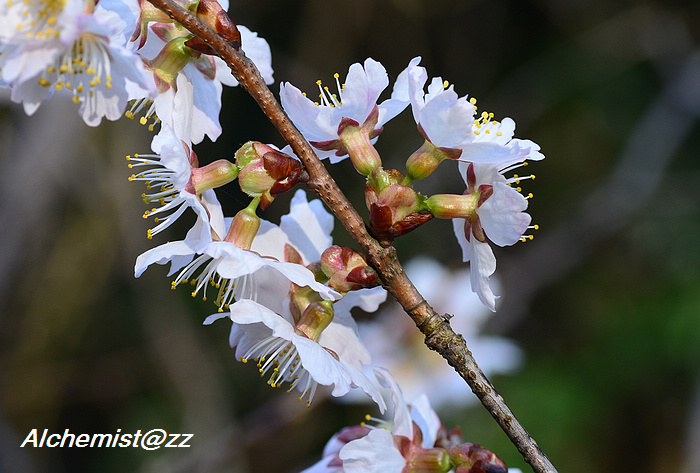- Scientific Name: Prunus conradinae Koehne
- Ref: C.S.Sargent, Pl. Wilson. 1:211. 1912
- Synonyms: Cerasus conradinae (Koehne) T.T.Yu & C.L.Li; Prunus occultipes (Koehne) H.Lév.
- Chinese Common Name: 华中樱桃 Huázhōng yīngtáo
- Family: Rosaceae
- Genus: Prunus
- Distribution: Forests in ravines, slopes; 500–2100 m. Fujian, Gansu, Guangxi, Guizhou, Henan, Hubei, Hunan, Shaanxi, Sichuan, Yunnan, Zhejiang.
- Photo: 03/22/2014, Tianlong Canyon, Lin’an, Zhejiang
Trees 3–10 m tall. Bark grayish brown. Branchlets grayish brown; young branchlets green, glabrous. Winter buds ovoid to elliptic-ovoid, glabrous or pilose. Stipules linear to oblong-lanceolate, ca. 6 mm, soon caducous after anthesis, margin gland-tipped fimbriate. Petiole 6–10 mm, glabrous or densely spreading villous, with 1–3 nectaries; leaf blade obovate, elliptic, or obovate-oblong, 4.5–9 × 2.5–4 cm, both surfaces glabrous, abaxially pale green, adaxially green, base rounded to broadly cuneate, margin biserrate or sharply serrulate and teeth with a punctiform apical gland, apex abruptly acuminate to caudate; secondary veins 6–9 on either side of midvein. Inflorescences umbellate, 2–5-flowered; involucral bracts brown, obovate-elliptic, 6–8 × 4–5 mm, abaxially glabrous or subglabrous, adaxially densely villous; peduncle 2–15 mm, rarely absent, glabrous or spreading pilose; bracts brown or green, ovate, suborbicular, or broadly fan-shaped, 1.3–8 mm, caducous or persistent in fruit, margin glandular serrate. Flowers ca. 1.5 cm in diam., opening before or nearly at same time as leaves. Pedicel 1–2.5 cm, glabrous. Hypanthium campanulate to tubular-campanulate, ca. 4 × 3 mm, outside glabrous. Sepals triangular to triangular-ovate, 2–2.5 mm, reflexed after flowering, apex obtuse to acute. Petals white or pink, oblong, ovate, or obovate, apically 2-lobed. Stamens 32–54. Style shorter to slightly longer than stamens, glabrous. Drupe red, ovoid to subglobose, 8–11 × 5–9 mm; endocarp ± sculptured, apex acute. Fl. Mar, fr. Apr–May. (Flora of China)
